The appetite of war. The consumption of artillery ammunition by the Russian army in the First World War
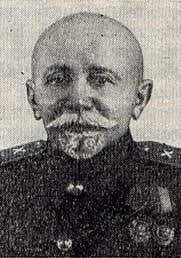
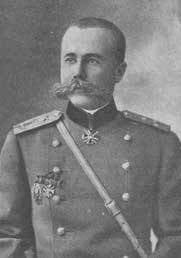
The root of the problem
At the beginning of the war, all the warring armies were in a critical situation - due to the expenditure of ammunition prepared before the war at erroneously underestimated standards (assuming short-term conflict).
The French artillery, brought up on the method of wasteful firing at squares, spent 1000 firing guns on the first 1914 battles in August. On Marne, she fired the last shells, and the parks sent by 15 on September 1914 to the unloading stations for ammunition replenishment returned empty (The kit was installed in 1700 shells on an 75-mm cannon, but by the start of the war there were only 1300 shots).
The lack of shots threatened the catastrophe of German artillery - in the winter period 1914 - 1915.
E. Z. Barsukov noted: "Russian artillery was able to shoot perfectly with respect for reasonable saving shells, but she was forced to resort to their wasteful expenditure under the pressure of orders from senior commanders, poorly familiar with the combat properties of artillery." As a result, the Russian artillery in the 5 month of the war was left without ammunition, having spent a mobilization supply of 76-mm shells (1000 for light and 1200 for a mountain cannon) by the beginning of 1915.
To meet the enormous, completely unforeseen need for ammunition, the warring countries had to involve all their industry in the manufacture of shells, gunpowder, explosives, pipes, etc., and to transfer orders abroad for enormous sums.
How great this need was only for the Russian army can be judged from the following data indicating the total number of some ammunition prepared for reserves before the war and during the Great War 1914 — 1917, namely:
The need for ammunition from other armies, both the allies of Russia and its opponents, far exceeded the needs of the Russian army. For example, French factories from August 1914 to November 1918. About 208250000 pieces of 75-mm shells were manufactured, i.e. almost 4 times more than the 76-mm shells for Russian artillery (around 54000000) were prepared, and French factories produced about 90-units, i.e., shells of medium and large caliber (220-65000000-mm) approximately 5 - 6 times more than was prepared for the Russian artillery.
The production of ammunition required a huge amount of raw materials. According to the calculations given in the work of M. Schwarte “Technique in World War”, for the manufacture of shells, explosives for equipment of the latter, sleeves, tubes, etc., in an amount corresponding to the production of each 10000 tons of gunpowder, approximately:
The extraordinary expenditure of funds for the procurement of ammunition was one of the most important reasons for the decline of the national economy in this period. And if, on the one hand, excessive procurement of expensive ammunition caused great damage to the national economy (millions of tons of fuel, metal and other raw materials are pumped out of the latter, working hands are diverted, etc.), then, on the other hand, too careful calculations of the need for ammunition and erroneous plans to meet this need put the army in a time of war in a critical situation.
Shells for light field guns
The first investigator of the World War I experience in supplying the army with ammunition was the former head of the State Aviation Administration A. A. Manikovsky, whose 3 part of labor (“Combat Supply of the Russian Army in 1914 - 1918”) covers this very question. Unfortunately, the indicated 3-I part was published in 1923 after the death of A. A. Manikovsky - according to his unfinished sketches, which leaves a mark on the content.
The 3 part of A. A. Manikovsky’s work tells us, for example, about the large consumption (maximum during the war) of 76-mm shells by Russian artillery in the 1916 campaign. 76-pieces of shells were spent on average 16815000-shells or about 1,5 million per month, but if 1500000 is divided into 30 days of the month and 6000 (the total number of field and mountain 76-mm guns then on the front) we get 8 - 9 shots per day per barrel - which, on the one hand, is extremely insignificantly (especially in comparison with the flow rates on the French front), and on the other hand, It binds, which could make the Russian artillery and with these rates of application.
However, this expense was considered "big." And the question of the reasons for the “large” expenditure of 76-mm shells was investigated by the above specialist with exhaustive completeness, first of all, on the basis of data from a report by General P.P. Karachan (1914 seconded to the South-Western Front in October with the task of finding out the reasons for an unexpectedly large spending 76-mm shells), as well as on the materials "Notes on the actions of Russian artillery during operations on the Western Front 5 - 15 March 1916" (The note was compiled by E. Z. Barsukov on the results of the trip to the Russian Western Front about the artillery inspector general to find out the reasons for the failure of the March 1916 operation, and was published by the BET that same year).
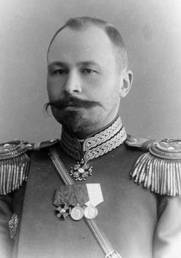
A. A. Manikovsky’s work rightly noted that the work of Russian artillery was excellent, according to both its own and its enemies, and that with such factors as the excellent training of Russian artillery, the magnificent 76-mm cannon and the proper amount of shells “brilliant the combat result was completely secured and there was no need to resort to violence against artillery (by the senior combined-arms commanders), which, without improving the results, caused projectile agitation and premature mother wear Flax part. "
In the fair opinion of A. A. Manikovsky, everything was very simple: it was enough to put certain tasks on the artillery, and to give the discretion of the artillery commanders themselves the technology question. But there is no - every combined-arms commander wanted to teach his own artillery "how it should fire, and at the same time less than on a hurricane of fire, and not otherwise, but for whole hours, it could not be reconciled".
Such "management" of artillery by the combined-arms military leaders caused obvious damage. But only with 1916 from Stavka, at the initiative of the Field Inspector-General of Artillery, separate instructions began to be received regarding combat use of artillery, and then “General guidelines for fighting for the fortified bands were issued in 1916. Part II, Artillery ", processed in 1917, in the statutory" Manual for the fight for the fortified bands. "
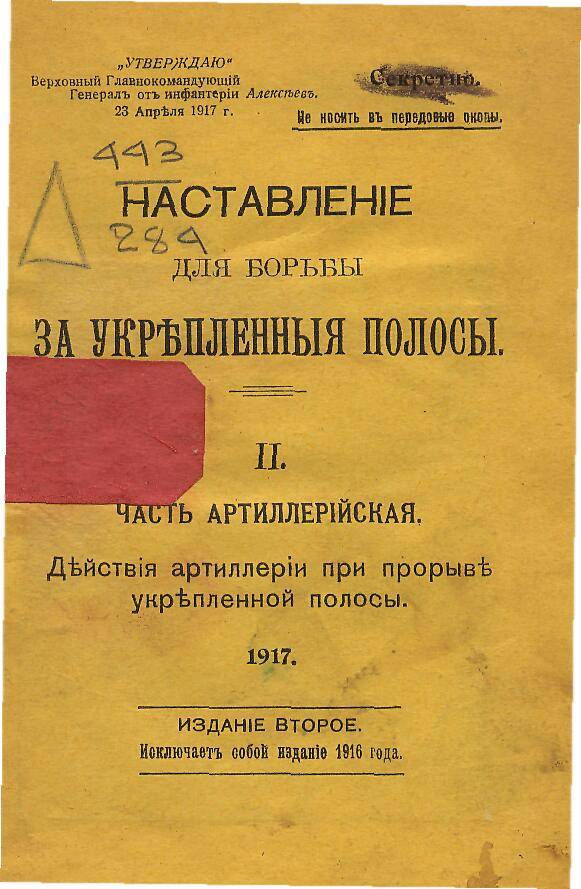
In particular, in the Manual it was stated that the validity of firing is achieved not by the unbridled expenditure of projectiles, but by methodical fire, expedient distribution of the latter along the front with observation of the effectiveness of each shot and the damage it produces (§ 131). You should also remove from use "hurricane" and similar to the latter types of fire, which generates a restless state of mind. Shooting without a clear goal is a criminal waste of shells (§ 132).
Order of the Supreme from 23. 04. 1917, accompanying the “Manual,” noted that, according to the testimony of military commanders, the use of the “General Guidelines for Fighting for Fortified Bands” was of immense benefit, while the violation of the key provisions set out in them often led to bloody failures, and the violation of the main provisions was due to the weak acquaintance of some combined-arms commanders with instructions to use the combat power of artillery. Finally, the following general statement of the same order should be noted: the Instruction should be applied in accordance with the situation, avoiding enslavement of figures and norms, because no norms can relieve commanders from the obligation to lead the battle and reflect.
All requests from the front in terms of the supply of 76-mm shells and almost all the standards established by the Office of the Field Inspector-General of Artillery (Upart Rates) of such supplies are A. A. Manikovsky considered obviously exaggerated. In the 1 edition of his work, after a series of calculations and comparisons of various data, a presumptive conclusion was made, which is based on the expenditure of shots for 1916 (this expenditure was determined by Upart for the Petrograd Union Conference in January 1917) - that the real need was no more than 1,5 million shots to 76-mm guns per month. The author recognizes the artillery body of the Bids Office as “competent”, but only in some cases. Calculated by Uphart monthly average consumption for 1914 - 1915. found to be fairly reliable, as a result of which conclusions were made: since the expense is small, the demands of the front, respectively, are exaggerated. Upart’s calculations of the average monthly consumption of shots for 1916, on the contrary, have no faith, and the Upart rate of 2229000 shots per month (for active combat operations of 5 months) is called exaggerated. The rate of 4,5 million per month, indicated in the letter written by Upart on the Head of the Emperor on April 15 of 1916, is considered by A. A. Manikovsky’s bid request, incurred in irreversible and obvious damage to other items of military supplies, including and above all for heavy artillery.
On the contrary, EZ Z. Barsukov considers the figures of the organs of the artillery control agencies of the Stavka to a large extent corresponding to the real state of affairs.
So, he noted that Upart started functioning at Headquarters only with 05. 01. 1916, and it was from that time that strict accounting of artillery fires began to be carried out - respectively, the calculations of Upart, referring to the period of its existence and the leadership of the artillery part of the army, are quite reasonable. On the contrary, the upart calculus compiled for 1914 - 1915. according to approximate data (when this body did not exist and there was almost no accounting of shots, and the disorganized supply at the front was not united under the leadership of the Stavka), they are considered somewhat more dubious. In addition, it should be noted that the average monthly consumption of 76-mm shells in 1914 - 1915. did not reflect their actual needs. This expenditure was small, because at the front there was an acute shortage of 76-mm shells, there was almost nothing to spend, and the need for shots was huge at that time. Therefore, it is wrong to ignore front requests for sending 76-mm shells, which came to GAU from the beginning of the war in abundance, considering them exaggerated (as was the case in the first edition of A. A. Manikovsky’s work).
The number of needs for 4,5 million 76-mm shells per month Wart calculated on the basis of data on the actual consumption of these munitions for a certain period of active operations 1916, on the South-Western Front. The figure in 4,5 million 76-mm projectiles was reported in a note to the Emperor Headquarters Headquarters as necessary for "full development of offensive operations on all our fronts" only for the next 2 - 3 summer months 1916. The purpose of the note is to indicate to the Emperor that it is difficult to perform conceived operations when it is impossible to ensure the enormous needs in combat supplies, pointing out the need to establish the post of supreme minister of state defense (similar to the post of French minister of supply). A copy of the note, for information, by the head of Upart was handed over to the head of the GAU, A. A. Manikovsky.
In the 1917 year, in connection with the events of the February Revolution, the order in the combat supply of the troops of the Army, established by Upart in 1916, was broken. Accordingly, the most reliable data on combat supplies, as noted by E. Z. Barsukov, is data mainly for 1916 and, partly, for August – September 1914 (the latter allow us to judge combat supplies during the maneuver war) .
Therefore, all the figures given by us in this cycle regarding the consumption of artillery ammunition by Russian artillery belong to the most competent specialist in this matter who had access to primary documentation - the former head of the Office of the Field General-Inspector of the General Headquarters artillery E. Z. Barsukov. The latter attempted, on the basis of Upart's data, to establish: 1) the average combat rate of 76-mm shells for the respective combat operations and 2) the average (mobilization) rate of need (stock) of 76-mm shells for a long (one year) war (or rate of average day of the year).
The ending should ...
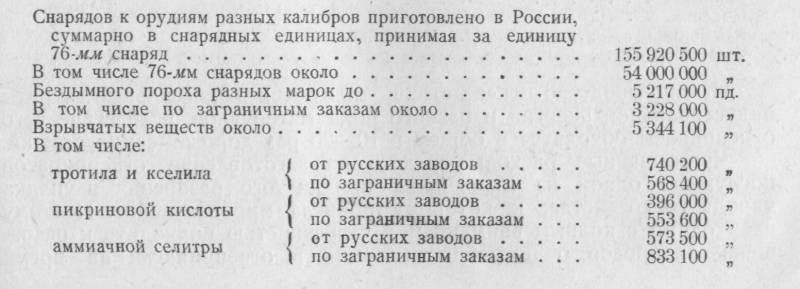
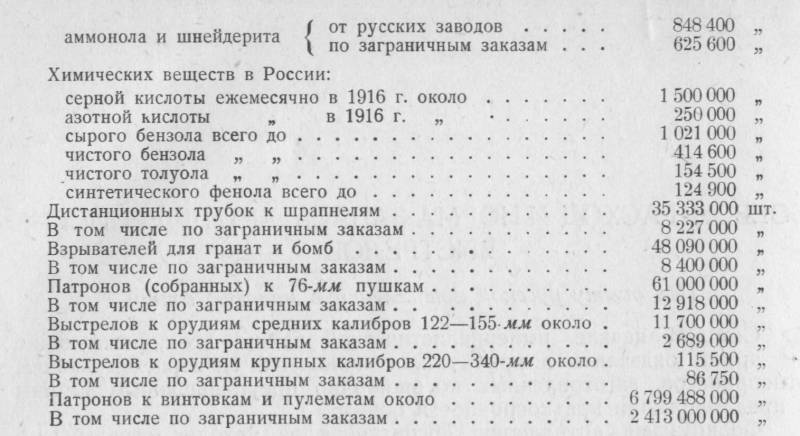

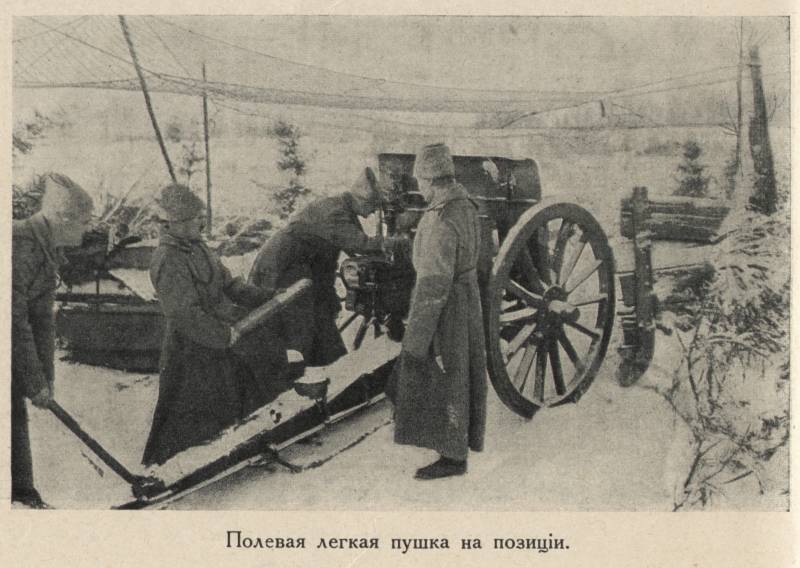
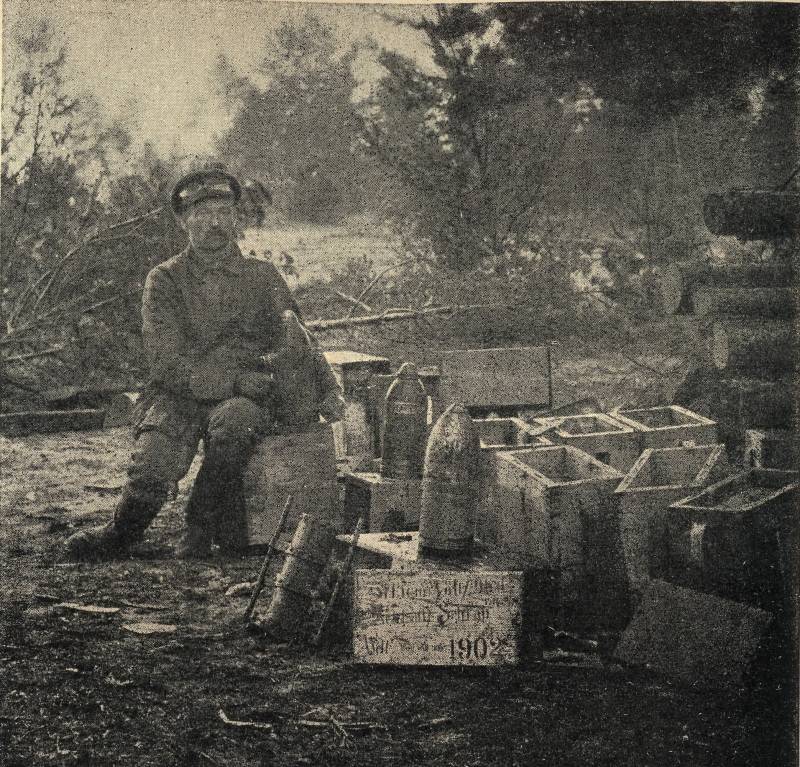
Information